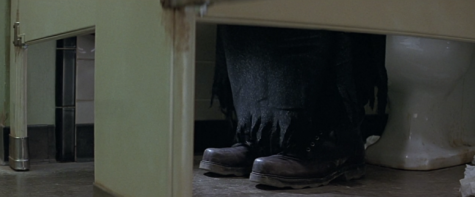Movie Monday with Luke: “Scream” savvy, worth discussion
October 26, 2015
It’s almost Halloween, so in the spirit of the season, why don’t we look at a slasher film this week? Let’s see…Which one would you like to watch? 1978’s “Halloween,” 1980’s “Friday the 13th,” or 1984’s “A Nightmare on Elm Street?” You know what, let’s just do a roulette. They’re all the same film anyway. Slasher films got by on using a single plot over and over, holding interest on waning shock value. Naturally, people eventually caught on, bringing a drought that lasted until the late Wes Craven’s “Scream” from 1996. Tired of the genre, Craven and screenwriter Kevin Williamson sought to beat up the genre with this mocking, self-aware flick, but for better or worse, he revived it in a reformed body.
“Scream” follows popular girl Dakota (Drew Barrymore) as she…dies in the first fifteen minutes. Then it follows a teen named Sidney (Neve Campbell) who struggles to get over her mother’s brutal murder, irritating her intense boyfriend Billy (Skeet Ulrich). She soon finds herself pursued by a psycho killer in a generic Ghostface Halloween costume, leading to an investigation headed by Deputy Dewey Riley (David Arquette), the older brother of her best friend Tatum (Rose McGowan). Meanwhile, her other ‘friends,’ annoying goofball Stu (Matthew Lillard) and geeky horror movie aficionado Randy (Jamie Kennedy), argue over whodunnit. With some lunatic on her tail trying to kill her and everyone she knows, Sidney has enough on her plate, but she’s also stalked by fame-seeking reporter Gale Weathers (Courtney Cox), who believes there to be a secret behind the murder of Sidney’s mother.
That sounds pretty much like your average slasher. The “mocking” part comes less from parody and more from the fact that most of the characters are horror movie fans. The killer leads up to his murders by chatting with his victims over the phone about their favorite horror movies, then chiding them for not knowing what to do in the actual situation. Sidney herself, grasping the situation, seeks to give her ‘movie’ a good outcome. Then there’s the fan-favorite Randy, who rattles off a list of things that will definitely get you killed in a horror movie. It’s cheeky fun, but if you take out the straightforward spoken references to other slasher films, it’s still just a slasher film. There aren’t any mind-blowing subversions of cliches; the characters mention them, and they happen. Acknowledgement doesn’t excuse tiredness, even its ‘surprises’ are torn from other films (for example, the fake protagonist in the opening from 1960’s “Psycho”).
The action is somewhat higher quality than standard fare: victims always get a fighting chance. Sometimes it’s humorous just how much Ghostface gets knocked down and yelps in his signature movie trailer-esque voice from Roger L. Jackson. But in the end, spoiler alert, no one is quite able to outsmart him. Apart from Sidney in early scenes (being the main character and all), the only way characters make it out of encounters with Ghostface alive is by magically surviving the same stabbings and gunshots that killed other characters. Don’t bother crying for anyone until the end of the movie. Perhaps it’s all part of the parody, but it’s a lot more dishonest than funny.

So, it’s your average slasher film pretending it’s something more, right? Well, there is one thing that sets it apart: the message. The reason slasher films were and, post-”Scream,” are so successful, despite the repetition, is that people are interested in killers and killing. When it comes to watching killers, people want to know how a person could become such a monster; a motive. When it comes to watching killing, people want to be shocked out of their coordinated, systematic lives. Wait…that’s a motive itself, isn’t it? Slasher films went out of style before “Scream” because they stopped being shocking. Eventually, people can lose the guilty pleasure they get from watching death. It can become less of a means for entertainment and more of a text. Then what? Well, mix in a mental disorder, pent-up anger and/or extreme peer pressure and you get the situation in “Scream.”
Not everyone has or will agree to what “Scream” has to say about violent media (though it wouldn’t be so popular if people didn’t ignore it), but the way it mirrors killers and killings that wouldn’t come until after its release, such as the Columbine massacre, is eerie, and testament to Williamson’s own savviness of horror. We remember Columbine the same way we remember “Halloween:” back then, it was horrifying, because it was one of the first. But now, mass killings with even more victims pass our consciouses in the matter of a couple months. As the killings escalate, the desensitization escalates…or is it vise versa?
For all the anger “Scream” let loose on the genre, it failed to kill it. Instead, it gave writers and directors a way to make their slasher films “witty” and “self-aware,” which has carried over into the new 10s with films like 2010’s “Tucker & Dale vs. Evil” and 2012’s “The Cabin in the Woods.” Even sequels to old franchises like “Child’s Play” changed their genres to comedy-horror to reap a little of what “Scream” sowed. And really, why not? It’s not hard to acknowledge cliches, nor to have a silly, ridiculous plot filled with over-the-top gore. It won’t get good reviews (unless it was touched by Joss Whedon), but it’ll make a buck.
True to its message, “Scream” inspired more than just copycat films; it’s also known for a decent gallery of real-life copycat killings. The film accomplishes pretty much the exact opposite of everything it wants. There’s no way the film could have gotten its musings about slasher films across to its intended audience without still being a slasher film. So, just like every other popular piece of violent media, psychos cling to it. It’s a given.
SHOULD YOU WATCH IT? “Scream” is the most interesting slasher film you’re likely to find. There aren’t too many surprises and it can seem a bit hypocritical and shallow in its self-awareness, but its analysis of violent media is worth a lot of thought and discussion.
WATCH IF YOU LIKE: Mary Harron’s “American Psycho” from 2002; “Scream” is another study of killers, though not quite as detailed.


